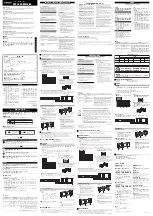
8
8. Testing Procedures
Testing consists of adjusting the valve set pressure, performing a seat
leakage test, and a back pressure test. The set pressure test is always
performed first.
Set Pressure Test:
1. Set pressure testing must always be performed using the appropriate
test fluid shown below.
2. Mount the valve on the test stand making a note of the set pressure and
cold differential test pressure (CDTP). The valve will be set at the CDTP.
On valves with blow down rings, set the ring two notches down from
contact with the disc holder (2600 Series) or disc (2850 & 2856 Series).
3. Hold the stem tightly and tighten (turn clockwise) the spring adjusting
screw to increase the set pressure. Make sure the stem does not
rotate while tightening the adjusting screw as this can damage the
seat and disc.
4. Slowly raise the test drum pressure and observe the opening (set)
pressure. The set pressure on air and steam is the point at which it
makes an audible pop. For water, the set point is the first continuous
flow of liquid that forms a stream perpendicular to the outlet approxi-
mately 1/16" thick.
5. If necessary, reduce the test drum pressure 25% below the opening
pressure and adjust the spring adjusting screw. Repeat this until the
valve opens at the required pressure, designated as the cold differential
test pressure (CDTP). The set pressure tolerance is equal to +3% of the
set pressure.
Pressure Relief Valve Test Fluids
Service Fluid
Test Fluid
Air, gas & vapor
Air or gas
Steam
Steam*
Liquid
Water
Table 2
*Air may be used for ASME Code Section VIII valves.
6. Lock the jam nut in place and pop the valve once more to ensure the
set pressure adjustment was not disturbed.
7. On 2600 Series valves, run the blow down ring down to the original
position recorded during disassembly. For the 2850 & 2856 Series, set
the ring at the following position down from contact with the disc: 3/4"
inlet - 6 notches, 1" & 1 1/2" inlets - 22 notches, and 2" & 3" inlets -
33 notches. Install the cap or lever assembly and wire seal the cap and
blow down ring lock screws to prevent tampering.
Back Pressure Testing:
1. The back pressure test applies to all valves designed to discharge to a
closed system. This includes valves with plain caps and packed lever
assemblies. Open lever valves and valves with exposed springs (open
bonnet) do not require this test.
2. The secondary pressure zone of all valves exceeding 1" inlet size shall
be tested with air or other suitable gas at a pressure of at least 30 psi. A
suitable leak detection solution will be used to verify tightness of all
gasket joints and vent/drain plugs.
3. If leakage is detected at any location, the valve should be reworked to
eliminate the leak path.
Содержание Curtiss-Wright 1890 Series
Страница 1: ...Technical Manual 1098T R1 Pressure Relief Valve Maintenance Manual ...
Страница 11: ...10 ...






























